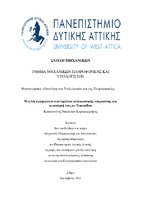| dc.contributor.advisor | Μαστοροκώστας, Πάρις | |
| dc.contributor.author | Καραπιπεράκης, Κωνσταντίνος | |
| dc.date.accessioned | 2022-10-03T07:56:35Z | |
| dc.date.available | 2022-10-03T07:56:35Z | |
| dc.date.issued | 2022-09 | |
| dc.identifier.uri | https://polynoe.lib.uniwa.gr/xmlui/handle/11400/2953 | |
| dc.identifier.uri | http://dx.doi.org/10.26265/polynoe-2793 | |
| dc.description.abstract | H Υπολογιστική Νοημοσύνη μπορεί να οριστεί επίσης ως συνέργεια υπολογιστικών συστημάτων, τα οποία οδηγούν μία μηχανή στην επίλυση προβλημάτων, που συνήθως λύνονται από ανθρώπους, χρησιμοποιώντας φυσική νοημοσύνη. Οι υπολογισμοί αυτοί, προσδίδουν χαρακτηριστικά νοημοσύνης στις μηχανές διότι στηρίζονται στα βασικά μοντέλα αναπαράστασης τεχνητού νευρώνα, τα οποία δομικά, είναι σε αντιστοιχία με τους νευρώνες του εγκεφάλου μας. Στο αρχικό κεφάλαιο της εργασίας, γίνεται αναφορά στα συστήματα ασαφούς λογικής, τα οποία βασίζονται στη θεωρία των ασαφών συνόλων και χρησιμοποιούν συναρτήσεις συμμετοχής για τους απαραίτητους υπολογισμούς. Επίσης γίνεται μελέτη στα τεχνητά νευρωνικά δίκτυα, παρουσιάζεται η βασική μορφολογία του βιολογικού νευρώνα και η απεικόνισή του στον αλγόριθμο του Perceptron, αλλά και στη βασική αρχιτεκτονική των νευρωνικών δικτύων. Παρουσιάζεται το νευροασαφές νευρωνικό δίκτυο ANFIS και αναλύονται δύο βασικές αρχιτεκτονικές των νευρωνικών δικτύων, τα αναδρομικά(RNN) και τα συνελικτικά(CNN) νευρωνικά δίκτυα. Στο δεύτερο κεφάλαιο, αναλύουμε τη βασική βιβλιοθήκη για την ανάπτυξη αρχιτεκτονικών των νευρωνικών δικτύων το TensorFlow, παρουσιάζουμε το Google Colaboratory, τον πιο βολικό τρόπο χρήσης του TensorFlow καθώς και όλες τις βασικές λειτουργίες της βιβλιοθήκης με τον κώδικα που τις ενεργοποιεί, σε γλώσσα προγραμματισμού Python. Στο τρίτο κεφάλαιο υλοποιούνται δύο μοντέλα ταξινόμησης εικόνων με διαφορετικές αρχιτεκτονικές
(CNN & RNN-LSTM) και ένα μοντέλο επεξεργασίας φυσικής γλώσσας (NLP). Στο τέταρτο κεφάλαιο αναλύεται η πλατφόρμα λογισμικού Anaconda όπως παρουσιάζεται από τον ιστότοπο anaconda.com. | el |
| dc.format.extent | 151 | el |
| dc.language.iso | el | el |
| dc.publisher | Πανεπιστήμιο Δυτικής Αττικής | el |
| dc.rights | Αναφορά Δημιουργού - Μη Εμπορική Χρήση - Παρόμοια Διανομή 4.0 Διεθνές | * |
| dc.rights.uri | https://creativecommons.org/licenses/by-nc-sa/4.0/deed.el | * |
| dc.subject | Tensorflow | el |
| dc.title | Μελέτη προηγμένων συστημάτων υπολογιστικής νοημοσύνης και υλοποίησή τους σε Tensorflow | el |
| dc.title.alternative | Study of advanced computing systems intelligence and their implementation in Tensorflow | el |
| dc.type | Μεταπτυχιακή διπλωματική εργασία | el |
| dc.contributor.committee | Κεσίδης, Αναστάσιος | |
| dc.contributor.committee | Bogris, Adonis | |
| dc.contributor.faculty | Σχολή Μηχανικών | el |
| dc.contributor.department | Τμήμα Μηχανικών Πληροφορικής και Υπολογιστών | el |
| dc.contributor.master | Επιστήμη και Τεχνολογία της Πληροφορικής και των Υπολογιστών | el |
| dc.description.abstracttranslated | Computational Intelligence can also be defined as the synergy of computer systems, which lead a machine to solve problems, which are usually solved by humans, using natural intelligence. These calculations give intelligence characteristics to machines because they are based on the basic models of artificial neuron representation, which are structurally in correspondence with the neurons of our brain. In the initial chapter of the paper, reference is made to fuzzy logic systems, which are based on the theory of fuzzy sets and use participation functions for the necessary calculations. Artificial neural networks are also studied, the basic morphology of the biological neuron and its representation in the Perceptron algorithm are presented, as well as the basic architecture of neural networks. The ANFIS neurofuzzy neural network is presented and two basic neural network architectures, recurrent (RNN) and convolutional (CNN) neural networks are analyzed. In the second chapter, we analyze the core library for developing neural network architectures TensorFlow, we present Google Colaboratory, the most convenient way to use TensorFlow as well as all the core functions of the library with the code that enables them, in Python programming language. In the third chapter, two image classification models with different architectures are implemented
(CNN & RNN-LSTM) and a natural language processing (NLP) model. The fourth chapter discusses the Anaconda software platform as presented by the anaconda.com website. | el |



